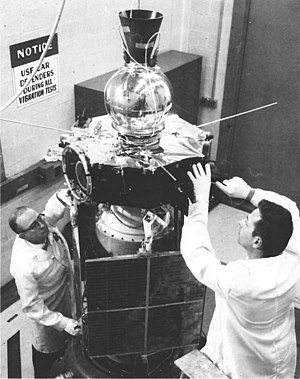 Explorer 35 satellite | |
| Names | IMP-E AIMP-2 Anchored Interplanetary Monitoring Platform-2 |
|---|---|
| Mission type | Space physics |
| Operator | NASA |
| COSPAR ID | 1967-070A |
| SATCAT no. | 02884 |
| Mission duration | 2167 days (achieved) |
| Spacecraft properties | |
| Spacecraft | Explorer XXXV |
| Spacecraft type | Anchored Interplanetary Monitoring Platform |
| Bus | AIMP |
| Manufacturer | Langley Research Center |
| Launch mass | 104.3 kg[1] |
| Payload mass | 23.1 kg (51 lb) |
| Dimensions | 71 × 20.3 cm (28.0 × 8.0 in) |
| Power | 70 watts |
| Start of mission | |
| Launch date | 19 July 1967, 14:19:02 GMT[2] |
| Rocket | Thor-Delta E1 (Thor 488 / Delta 050) |
| Launch site | Cape Canaveral, LC-17B |
| Contractor | Douglas Aircraft Company |
| Entered service | 19 July 1967 |
| End of mission | |
| Deactivated | 24 June 1973 |
| Orbital parameters | |
| Reference system | Selenocentric orbit |
| Periselene altitude | 764 km (475 mi) |
| Aposelene altitude | 7,886 km (4,900 mi) |
| Inclination | 147.30° |
| Period | minutes |
| Lunar orbiter | |
| Orbital insertion | 21 July 1967 |
| Instruments | |
| AMES Magnetic Fields Bistatic Radar Observations of the Lunar Surface Electron and Proton Detectors GSFC Magnetometer Low-Energy Integral Spectrum Measurement Experiment Micrometeorite Flux Plasma Probe Selenodetic Studies Solar Cell Damage | |
Explorer 35, (IMP-E, AIMP-2, Anchored IMP-2, Interplanetary Monitoring Platform-E), was a spin-stabilized spacecraft built by NASA as part of the Explorer program. It was designed for the study of the interplanetary plasma, magnetic field, energetic particles, and solar X-rays, from lunar orbit.[3]
- ^ "Explorer 35". NASA Solar System Exploration. NASA's Solar System Exploration website. Retrieved 30 November 2022.
- ^ "Launch Log". Jonathan's Space Report. 21 July 2021. Retrieved 11 November 2021.
- ^ "Display: Explorer 35 (AIMP-2) 1967-070A". NASA. 28 October 2021. Retrieved 11 November 2021.
 This article incorporates text from this source, which is in the public domain.
This article incorporates text from this source, which is in the public domain.